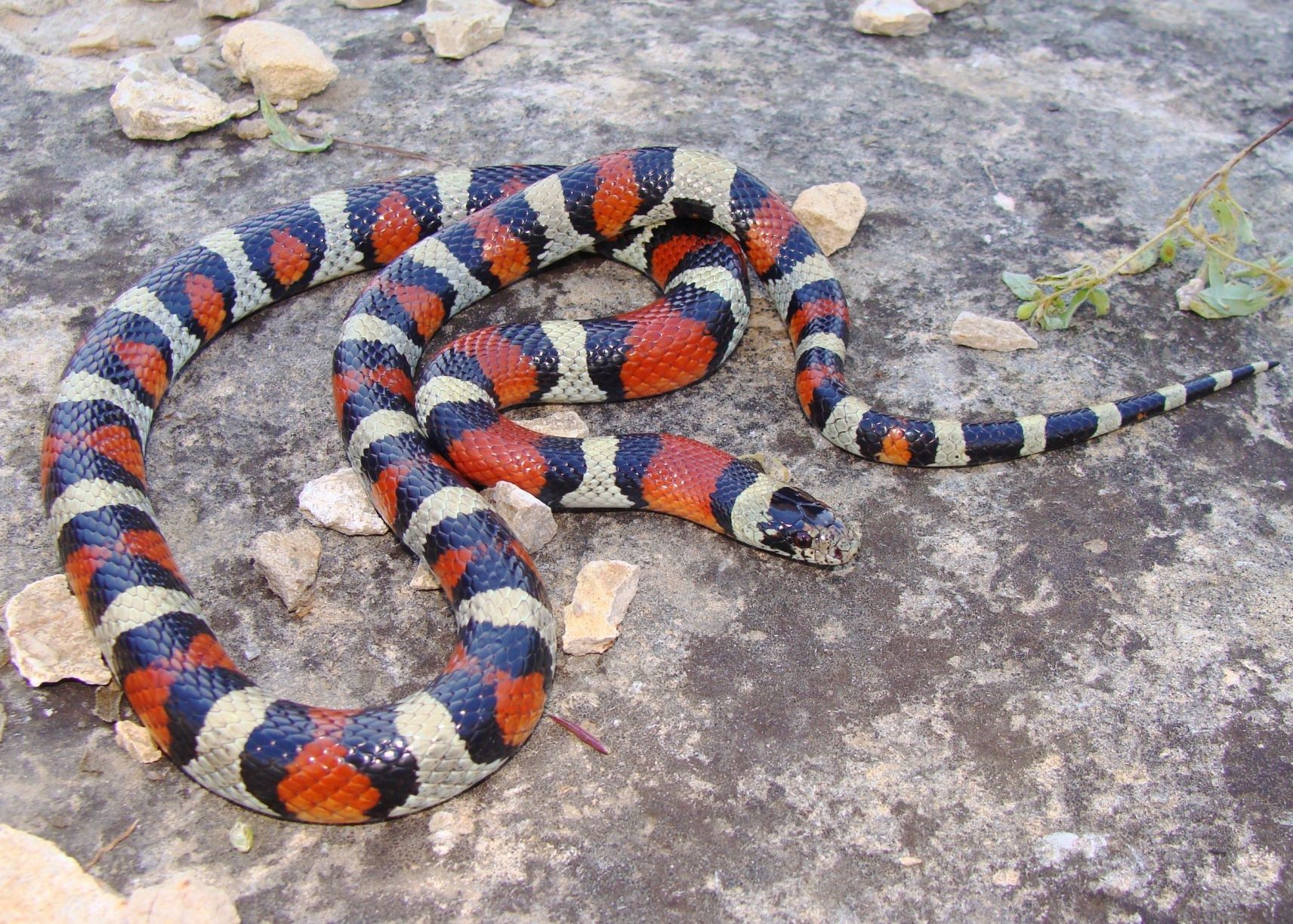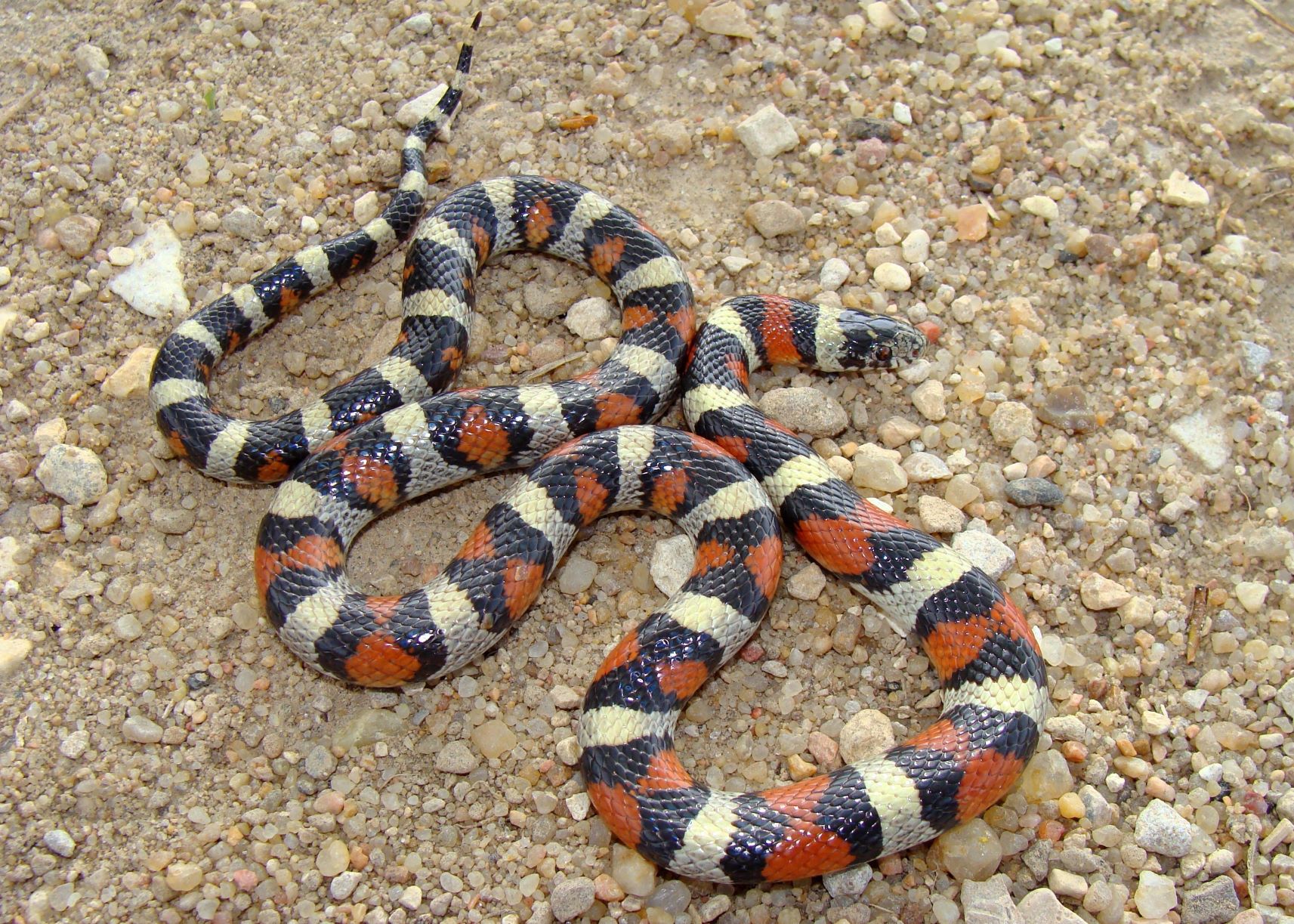What is the smallest Milk Snake? And would it make a good pet? Let’s find out more about the smallest member of the Milk Snake group…
Last updated on February 1st, 2023 at 09:34 am
Milk Snakes are a wide-ranging species complex with over twenty species, subspecies and localities. Of these, the smallest is the New Mexico Milk Snake; a brightly coloured denizen of arid grassland. In great part due to their reclusive habits, theses snakes are often no more than 18 inches (45cm) long.
Milk Snake Size
Though technically very similar, the various varieties of Milk Snake (Lampropeltis triangulum and close relatives) are highly disparate in size. What they have in common, however, is their bright colouration. Almost every single variety of Milk Snake is a brightly coloured Coral Snake mimic.
This habit of copying the bright aposematic colours of a venomous species is called Batesian Mimicry (named after the great naturalist H. W. Bates, who first described it). For Milk Snakes, this Batesian Mimicry means that they have bright red, yellow or white, and black markings.
For us reptile enthusiasts, this makes finding a wild Milk Snake – or getting a captive-bred one as a pet – particularly exciting. The problem is, some Milk Snakes do not stay small. I’ve seen captive Honduran Milk Snakes, for example, that were over 4 feet (1.2m) in length. At this size, they are spectacular.
The thing is, not everyone has room for a snake over 4 feet long. It’s just a fact. A lot of enthusiasts prefer the convenience of smaller, more manageable snakes.
If this is you, then the ever-variable Milk Snake complex has you covered. There are many Milk Snakes that rarely get more than 24 inches (60cm) long.
In fact, the New Mexico Milk Snake (Lampropeltis gentilis) – the smallest variety of all – would be dwarfed by a Honduran Milk Snake. Most New Mexico Milk Snakes only reach 18 inches (45cm), and some only 16 (40cm). In fact, the largest New Mexico Milk Snake ever recorded was only 24 inches (60cm) long.
As you’re about to find out, it isn’t easy to find a New Mexico Milk Snake in the wild, or as a pet. but there are other small subspecies that are common in captivity, however, which we will discuss.
List of Milk Snake subspecies past and present:
- Andean Milk Snake
- Atlantic Central American milk snake
- Black Milk Snake
- Blanchard’s Milk Snake
- Central Plains Milk Snake
- Conant’s Milk Snake
- Dixon’s Milk Snake
- Eastern Milk Snake
- Guatemalan Milk Snake
- Honduran Milk Snake
- Jalisco Milk Snake
- Louisiana Milk Snake
- Mexican Milk Snake
- Nelson’s Milk Snake
- New Mexico Milk snake
- Pacific Central American Milk Snake
- Pale Milk Snake
- Pueblan Milk Snake
- Red Milk Snake
- Sinaloan Milk Snake
- Smith’s Milk Snake
- Stuart’s Milk Snake
- Utah Milk Snake
Some of these subspecies are no longer recognised scientifically, but still often referred to by enthusiasts as “localities.” By locality, we mean a variety of a species that is not recognized as a true subspecies, but still differs in size or coloration to other members of its species.
Other subspecies on the list have now been declared full species – you can read more about this in the study: Coalescent Species Delimitation in Milksnakes (Genus Lampropeltis) and Impacts on Phylogenetic Comparative Analyses

New Mexico Milk Snake
Scientifically known as Lampropeltis gentilis, the New Mexico Milk Snake is the smallest locality of Milk Snake known. It is a variety of the Western Milk Snake.
In the wild, it is probably of of the least commonly encountered. It may also be one of the least observed, and possibly even one of the least understood.
It prefers dry, rocky grassland areas in southeast New Mexico and west Texas (Big Bend region). In this habitat it spends the day hiding and comes out to hunt at night.
During the day, when it is hiding, it almost never encounters humans. If an animal is hiding under a rock, that itself is surrounded by dry grass, it is essentially invisible.
It is for this reason that for many years, zoologists and herpers alike believed that the New Mexico Milk Snake was rare, and potentially a threatened species.
At one point, it even received legal protection, due to how rare it appeared to be. These days, following several surveys of its population, we now know that this locality is in fact quite common.
It would seem New Mexico Milk Snakes do in fact occur in good numbers – they’re just incredibly shy and hard to find. The fact that they are also nocturnal, and so very small, undoubtedly adds to how uncommon it is to encounter them.
New Mexico Milk Snake habitat and natural history
These snakes live in a tough neck of the woods. Their habitat gets exceptionally hot and dry during the summer, and they must compete with King Snakes and Coachwhips for food and habitat. Obviously, King Snakes and Coachwhips will also eat them if given the chance.
The solution is to spend a lot of time hiding and be able to squeeze into the tiniest limestone crevices to escape their would-be predators. This is probably precisely why L. gentilis is as small as it is.
When it comes to their own diet, the New Mexico Milk Snake seems to prefer small lizards and very small snakes, such as Black-headed Snakes (Tantilla spp.) . Nonetheless, they will accept rodents and reptile eggs as food.
Like most other North American Milk Snake varieties, the New Mexico Milk Snake goes through a brumation period during the winter. During this time it reduces its activity and conserves energy.
In spring, when the weather warms up, these little snakes breed and lay small clutches of eggs by late June. The young hatch afer roughly two months and are only around 6 inches (15cm) long.
New Mexico Milk Snake lifespan
The lifespan of the New Mexico Milk Snake is hard to determine, as it is rarely kept in captivity. If we take estimates from the lifespan of related snakes, however, we can come to a reasonable estimate of 12 to 18 years under ideal conditions.

Milk Snakes for sale
As I mentioned earlier, New Mexico Milk Snakes are rarely encountered – either in captivity or the wild. The fact that they were previously protected seems to have prevented them from becoming widespread in the reptile hobby.
This is unfortunate, as accounts of these snakes as pets all refer to them as easy-going captives that often adjust well to a diet of small rodents. If you’re looking for a small Milk Snake, it is true that a New Mexico Milk would be perfect – but they are just too hard to find captive-bred.
The problem is that wild-caught snakes are often in poor condition when you buy them. They are either dehydrated, full of parasites – or both. Not to mention the fact that it is unethical to keep wild-caught animals when we have so many healthy captive-bred ones to choose from.
Instead, look out for a similar alternative, such as the Sinoloan Milk Snake, or the Pueblan Milk Snake. Both subspecies are just as beautiful as the New Mexico variety, and only slightly larger.
Other small Milk Snakes list:
- Pueblan Milk Snake
- Sinoloan Milk Snake
- Stuart’s Milk Snake
- Mexican Milk Snake
The Pueblan Milk Snake also comes in a beautiful “Apricot” morph that is stunning to look at. (You can read more about them in my article on small pet snakes).
When looking for a pet Milk Snake, your best bet is to look on the Milk Snake section of Morphmarket. This is an online marketplace where you can buy directly from breeders. You can also look at their feedback and reviews to make sure you’re buying from someone reputable.

New Mexico Milk Snake Summary Table
| Common name: | New Mexico Milk Snake, Western Milk Snake |
| Scientific name: | Lampropeltis gentilis, formerly Lampropeltis triangulum celaenops |
| Size: | Adults: 18 inches (45cm), 6 inches (15cm). Record: 24 inches |
| Range: | Scattered patches New Mexico, west Texas |
| Habitat: | dry and rocky grassland/limestone outcrops |
| Diet: | small lizards and small snakes, rodents, reptile eggs |
| Lifespan: | 12 to 18 years under ideal conditions |
Conclusion
The New Mexico Milk Snake is the smallest and perhaps one of the most secretive of the Milk Snake susbspecies and localities.
This means that it was previously considered rare, and never really took off in the pet trade. Overall, if you’re looking for a small pet snake, then you’re better off looking for one of its relatives that we’ve discussed here.
If you’re a herper, however, finding a New Mexico Milk Snake is a good challenge. Just remember that in Texas it is now illegal to look for snakes on public land or roadways without a licence! It’s all part of the widespread crackdown on reptile enthusiasts.
And yes, this means even if you only want to photograph them. Always stick to private land if you can and thoroughly research both state and county laws before you go herping anywhere in the US.

